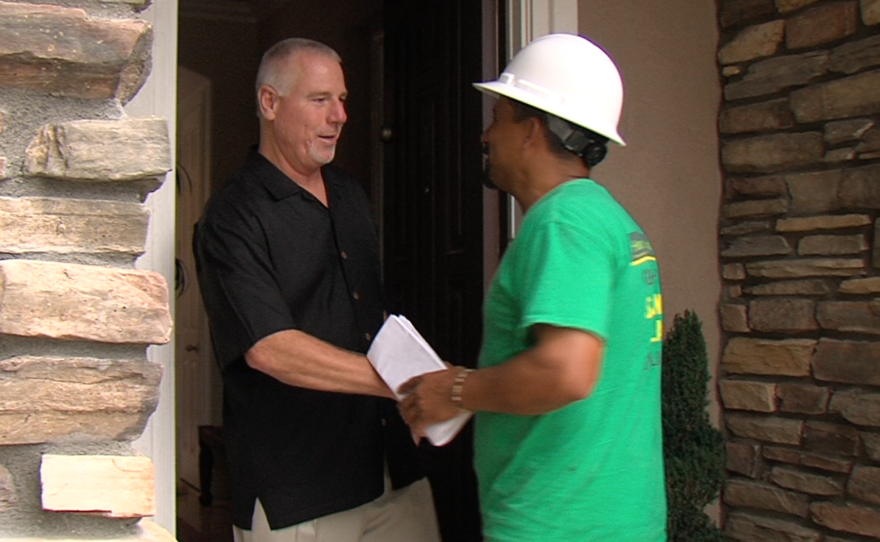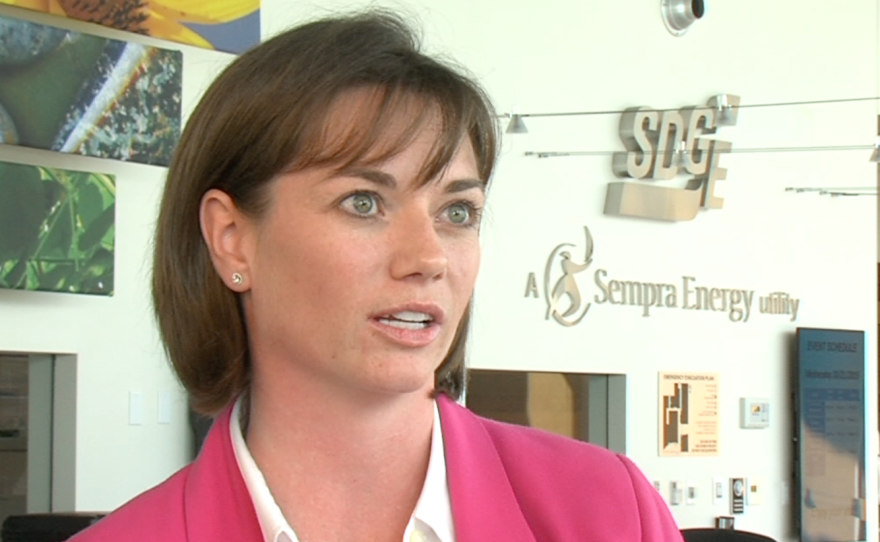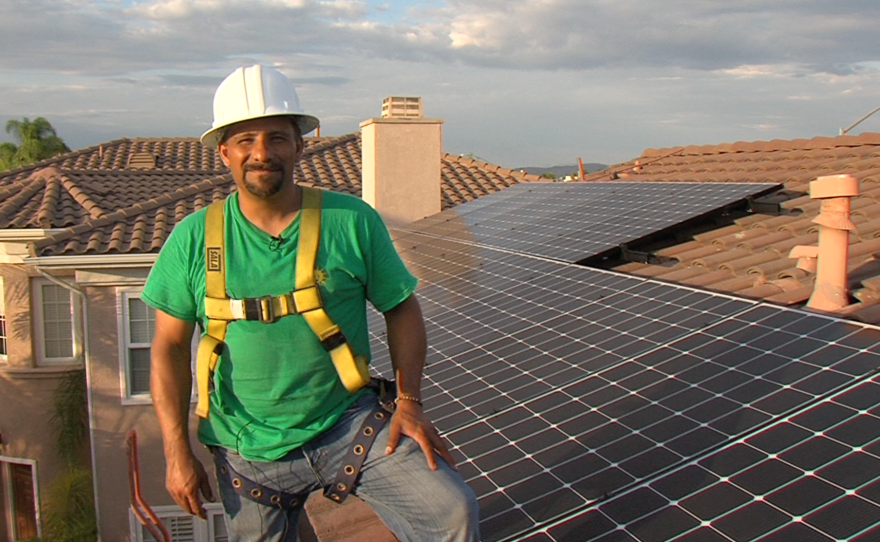It's an unusually cloudy day in San Diego as Phil Salas wraps up a solar panel installation project at a home in Carmel Valley. He shouts out the all-clear to his crew on the roof, and a motorized lift hoists the large, surprisingly lightweight panels to the spot where they're set to be screwed on.
This is one of dozens of projects Salas oversees as project manager for Home Energy Systems, a solar panel installation business. San Diego's moderate climate and abundance of sunny days make it an ideal place to turn the sun into electricity, and the city ranked last year among the top five nationwide in terms of total solar capacity and capacity per capita.
Salas said Home Energy is booked through the end of the year and has had to hire temporary workers to keep up with the growing demand.
But casting a shadow over the solar boom is the fast-approaching expiration of California's net energy metering program, which allows solar customers to sell back to the grid excess power generated by their solar panels.
Solar proponents say it has been one of the most powerful tools to encourage the adoption of solar power among homeowners, schools and businesses. The program's exact end date in San Diego isn't known — experts expect it to come sometime in the first half of next year — and state regulators have not yet announced its replacement.
Salas attributes some of the most recent growth in business to a sense of urgency among homeowners to get grandfathered into the current rules.
"But if SDG&E gets exactly what they want, I really don’t see very many (solar) companies staying in business,” he said.
Financial incentives matter
Under net metering, customers whose solar panels produce more electricity than they consume sell back to the utility the excess power at retail rates, which can make their electricity bills significantly cheaper.
San Diego Gas & Electric is lobbying state regulators to lower those rates to wholesale, saying it would be cheaper to produce the same amount of electricity itself or buy it from another power producer.

That proposal does not sit well with Ron Johnson, the Carmel Valley homeowner getting about 50 panels installed on his roof.
“If I have extra energy, I expect to get top dollar for it,” Johnson said.
Because his solar panels will switch on before the expiration of the current system, Johnson will not be affected by the change in rules. While the environmental benefits were a factor in his decision to install the solar panels, he said the primary reason was financial.
“We use a high amount of energy,” he said. “This time of year we’re running the AC almost 24/7. We have three kids. We have a big home. We like to be comfortable. ... Not everybody has as big a use as some families. And we’re kind of on the high end, so we’re just trying to find the best way to save the most money.”
The costs of net metering
SDG&E said its non-solar customers are paying about $100 a year to subsidize the costs of rooftop solar panels.
"It's been 20 years since that program was started," said SDG&E spokeswoman Amber Albrecht. "And we feel that the industry has shown that it's here to stay and is ready to stand on its own two feet."
Albrecht's claim is supported by an extensive study completed in 2013 for the California Public Utilities Commission. The study confirmed that net metering has a net cost to electricity ratepayers — solar customers still use the distribution grid but pay far less for its maintenance than their non-solar counterparts — and that the cost is expected to rise if net metering is not changed.

Some environmentalists and solar experts say as an investor-owned utility with a guaranteed rate of return, SDG&E is more concerned with profits and less concerned with the environment than publicly owned utilities or utility cooperatives. Albrecht rejected that criticism, saying the utility has done a lot to empower renewable energy for its customers, including tips on how to conserve and energy alerts to make customers aware of high usage.
"In the future, we're going to have a program where our customers can choose how much renewable energy they want — be it 100 percent renewable energy or be it investing in a solar project in their backyard," she said.
SDG&E scored well in a ranking of utility companies' solar portfolios published by the Solar Electric Power Association. In the 2014 list, SDG&E placed third in the country in terms of total megawatts generated from solar — following Pacific Gas & Electric and Southern California Edison, respectively — and fifth in terms of watts per customer. In the latter ranking, it came out ahead of PG&E and Edison.
State, federal programs expiring
The upcoming change in net metering is part of a broader trend of winding down state and federal incentives for solar panels. The California Solar Initiative offered cash rebates for solar panels, but the funds have been exhausted for all residential SDG&E customers though some commercial ratepayers in San Diego still qualify. And a federal tax credit for renewable energy assets like solar panels is due to expire at the end of 2016, unless renewed by Congress.
Despite the changes to incentive programs, the solar industry is nowhere near demise, according to Scott Anders, director of the Energy Policy Initiatives Center at the University of San Diego. The price of solar panels has plummeted in recent years, he said, and efficiency continues to improve.
"There will be consolidation in the solar market. There will be mergers and acquisitions. ... Maybe growth will slow," Anders said. "But I think the mid- and long-term outlooks are good. That’s not great consolation for a company now trying to make payroll, or trying to figure out what their (second quarter) looks like in 2016. (But) I don’t think solar’s going to go away."
Public hearing with PUC
The Public Utilities Commission has until the end of the year to announce its new rules for "net metering 2.0," and so far it has given little indication of what the new system will look like.
That uncertainty led state Sen. Marty Block, D-San Diego, to request a public meeting for San Diego County residents and representatives of the commission. The meeting is set for Wednesday and will also include representatives from SDG&E and the California Solar Energy Industries Association.
Net Metering Meeting
What: California Public Utilities Commission is holding a hearing in San Diego to discuss upcoming changes to net metering.
When: 1 to 4 p.m. Wednesday
Where: City Administration Building, 202 C St., 12th Floor Council Chambers
“Solar companies have come to my office and said that with the change in net metering rules on the horizon, it’s really having a chilling effect on their business," Blocks said. "And the San Diego companies and San Diego solar customers haven’t really had the chance to give their input yet.”
Block said SDG&E may be correct when it says customers without solar are subsidizing those with solar. But, he said, solar customers are contributing to society in other ways.
"As the air is cleaner, down the road there will be fewer children with asthma," he said. "So it’s hard to calculate, based just on electric rates they’re paying, what the value of solar is.”
California is aiming for a 40 percent reduction in greenhouse gas emissions over the next 15 years, and an 80 percent reduction by 2050. Salas, the solar panel installation manager, said he is proud to work in an industry that is helping California meet those goals, and that he fears the change in net metering could mean he and his co-workers could be soon out of jobs.
“These are your friends, your neighbors, your family members," Salas said. "These are real people that love their jobs. They love what they do, and they do it for more than just a paycheck.”







